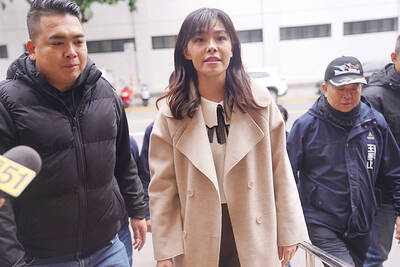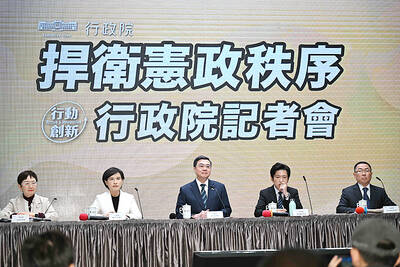Taiwan’s semiconductor firms are expected to invest US$210 billion over the next five years to cement the country’s lead over its peers in the global IC market, National Development Council Minister Kung Ming-hsin (龔明鑫) said on Friday.
Digital transformation in the high-tech sector had become an irreversible international trend, Kung told an investment forum on business start-ups.
The government would continue to encourage the local semiconductor industry to invest by providing incentives under the Statute for Industrial Innovation (產業創新條例), Kung said.

Photo: Bloomberg
Taiwanese semiconductor firms are expected to move their investments out of the China due to a restructuring of global supply chains amid escalating trade frictions between the US and China, he said.
“It is estimated that the local semiconductor industry will invest US$210 billion globally over the next five years to lay a good foundation for future development,” he said.
Citing Taiwan Semiconductor Manufacturing Co (TSMC, 台積電) chairman Mark Liu (劉德音), Kung said the global semiconductor industry would experience a golden era over the next one to two decades.
TSMC, the world’s largest contract chipmaker, is investing US$40 billion to build two advanced wafer fabs in Arizona: One is expected to start commercial production in 2025 and the other in 2026.
TSMC is also spending ¥37.8 billion (US$252.9 million) to build a fab in Kumamoto, Japan, through a joint venture. It is scheduled to begin production next year.
The company’s board has also approved a plan to form a joint venture to set up a wafer fab in Dresden, Germany.
TSMC has said it plans to invest up to 3.499 billion euros (US$3.8 billion) for a 70 percent stake in the new company, with mass production scheduled to start at the end of 2027.
TSMC’s global expansion has prompted its suppliers to follow suit, including Marketech International Corp (帆宣), a facility monitor control system provider, which said it already has a team in the US and is planning to expand its presence there because of TSMC’s Arizona project.
In addition, automated equipment supplier Mirle Automation Corp (盟立) said it wants to stay geographically close to TSMC to be able to provide it with timely services, while IC packaging and testing services provider ASE Technology Holding Co (日月光投控) is studying possible investments in the US.
Taiwan-based GlobalWafers Co (環球晶圓), the world’s third-largest silicon wafer maker, late last year began construction of a 12-inch silicon wafer plant in Texas at a cost of US$5 billion, with the aim of beginning mass production next year.
In response to concerns that an increase in overseas investment would affect the local IC industry, Kung said that Taiwanese semiconductor firms are expected to develop the sophisticated 3-nanometer process or more advanced technologies at home.
Regarding mature processes, Taiwanese semiconductor IC suppliers would take into account the needs of their clients by relocating resources to other countries such as Japan, Singapore and Malaysia, as more countries believe semiconductors are relevant to national security, Kung said.
“Global expansion by the local semiconductor industry is expected to strengthen its power, but 90 percent of Taiwanese IC suppliers’ production will stay in Taiwan,” he said.
Changes in the global supply chains are expected to show how critical Taiwan’s semiconductor industry is to the world, but would also test its resilience, Kung said.
To tackle rapidly changing global economic conditions, the government would continue to encourage local and foreign firms to invest in Taiwan and forge closer international partnerships to drive local growth, he said.

The US government has signed defense cooperation agreements with Japan and the Philippines to boost the deterrence capabilities of countries in the first island chain, a report by the National Security Bureau (NSB) showed. The main countries on the first island chain include the two nations and Taiwan. The bureau is to present the report at a meeting of the legislature’s Foreign Affairs and National Defense Committee tomorrow. The US military has deployed Typhon missile systems to Japan’s Yamaguchi Prefecture and Zambales province in the Philippines during their joint military exercises. It has also installed NMESIS anti-ship systems in Japan’s Okinawa

‘WIN-WIN’: The Philippines, and central and eastern European countries are important potential drone cooperation partners, Minister of Foreign Affairs Lin Chia-lung said Minister of Foreign Affairs Lin Chia-lung (林佳龍) in an interview published yesterday confirmed that there are joint ventures between Taiwan and Poland in the drone industry. Lin made the remark in an exclusive interview with the Chinese-language Liberty Times (the Taipei Times’ sister paper). The government-backed Taiwan Excellence Drone International Business Opportunities Alliance and the Polish Chamber of Unmanned Systems on Wednesday last week signed a memorandum of understanding in Poland to develop a “non-China” supply chain for drones and work together on key technologies. Asked if Taiwan prioritized Poland among central and eastern European countries in drone collaboration, Lin

BACK TO WORK? Prosecutors said they are considering filing an appeal, while the Hsinchu City Government said it has applied for Ann Kao’s reinstatement as mayor The High Court yesterday found suspended Hsinchu mayor Ann Kao (高虹安) not guilty of embezzling assistant fees, reducing her sentence to six months in prison commutable to a fine from seven years and four months. The verdict acquitted Kao of the corruption charge, but found her guilty of causing a public official to commit document forgery. The High Prosecutors’ Office said it is reviewing the ruling and considering whether to file an appeal. The Taipei District Court in July last year sentenced Kao to seven years and four months in prison, along with a four-year deprivation of civil rights, for contravening the Anti-Corruption

NO CONFIDENCE MOTION? The premier said that being toppled by the legislature for defending the Constitution would be a democratic badge of honor for him Premier Cho Jung-tai (卓榮泰) yesterday announced that the Cabinet would not countersign the amendments to the local revenue-sharing law passed by the Legislative Yuan last month. Cho said the decision not to countersign the amendments to the Act Governing the Allocation of Government Revenues and Expenditures (財政收支劃分法) was made in accordance with the Constitution. “The decision aims to safeguard our Constitution,” he said. The Constitution stipulates the president shall, in accordance with law, promulgate laws and issue mandates with the countersignature of the head of the Executive Yuan, or with the countersignatures of both the head of the Executive Yuan and ministers or